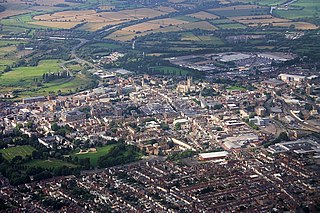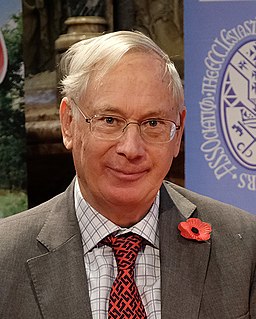White City is an estate in the City of Gloucester. It takes its name from the original white concrete houses. [1]

Gloucester is a city and district in Gloucestershire, in the South West of England, of which it is the county town. Gloucester lies on the River Severn, between the Cotswolds to the east and the Forest of Dean to the west, 19 miles (31 km) east of Monmouth, 17.5 miles (28.2 km) east of Wales. It has the first traditional crossing point across the longest river in the country, modernised into multiple lanes, connecting Over, a place over the water hence the name of that village — southern counties of England for many decades have been linked by three very long, lower Severn crossings in the very south-west corner of Gloucestershire, quite close to Bristol and Avonmouth on the far side of which is the River Wye being the border of South Wales for several miles.
Following World War I, there was a national movement to improve working-class housing, and rehouse families living in city centre slums. Land nearby had already been used for model housing in 1914, forming Northfield Road and Northfield Square. In 1927, Gloucester Corporation compulsorily purchased Starveall Farm to build the new homes that became White City. [2]

World War I, also known as the First World War, the Great War, the Seminal Catastrophe, and initially in North America as the European War, was a global war originating in Europe that lasted from 28 July 1914 to 11 November 1918. Contemporaneously described as "the war to end all wars", it led to the mobilisation of more than 70 million military personnel, including 60 million Europeans, making it one of the largest wars in history. It is also one of the deadliest conflicts in history, with an estimated nine million combatants and seven million civilian deaths as a direct result of the war, while resulting genocides and the resulting 1918 influenza pandemic caused another 50 to 100 million deaths worldwide.
The estate was formally opened by the Duke of Gloucester, in a tree-planting ceremony held on 14 July 1928. In the 1990s, the estate was substantially rebuilt. Many of the old homes were demolished by Gloucester City Council, and new homes built by Oxbode Housing Association and Beazer Homes. [3]

Prince Henry, Duke of Gloucester, was the third son and fourth child of King George V and Queen Mary. He served as Governor-General of Australia from 1945 to 1947, the only member of the British royal family to hold the post.

Gloucester City Council is the local authority for Gloucester, which is split into 18 wards, with a total of 39 councillors elected to serve on the City Council. Following the last election in 2016 there were 22 Conservative Councillors, 10 Labour Councilors, and 7 Liberal Democrat councillors. The current composition is 20 Conservative, 9 Labour, 9 Liberal Democrat, and 1 independent; the Liberal Democrats gained 1 seat from each of the Conservatives and Labour, and Conservative councillor Lee Hawthorne is currently suspended from the party.
Roads in the estate include Avening Road, Barkis Bungalows, Barnfields, Beaufort Road, Bibury Road, Broadway, Darwin Road, Dickens Close, Finlay Place, Finlay Road, Hazelton Close, Nickelby Bungalows, Northfield Road, Northfield Square, Reservoir Road, Sapperton Road, Selwyn Road and Stow Close. [4] The street names reference Gloucestershire villages as well as characters from the novels of Charles Dickens who had visited Gloucester docks in the 1850s. [5]

Charles John Huffam Dickens was an English writer and social critic. He created some of the world's best-known fictional characters and is regarded by many as the greatest novelist of the Victorian era. His works enjoyed unprecedented popularity during his lifetime, and by the 20th century, critics and scholars had recognised him as a literary genius. His novels and short stories are still widely read today.
Despite its long standing, White City did not appear on any official maps of Gloucester. Residents of White City successfully campaigned for their neighbourhood to be recognised officially as a district of the City, and to appear on maps and road signs. [6] In October 2012, the present Duke of Gloucester was invited back to mark White City’s new standing. [7]

Prince Richard, Duke of Gloucester, is the youngest grandchild of King George V and Queen Mary. He practised as an architect until the death of his elder brother placed him in direct line to inherit his father's dukedom of Gloucester, which he inherited, as the second duke, in 1974. He is a paternal cousin of Queen Elizabeth II, and currently 27th in the line of succession to the British throne as well as the first in line not descended from King George VI. After the Queen he is the senior male line descendant of three British monarchs: Victoria, Edward VII and George V.













